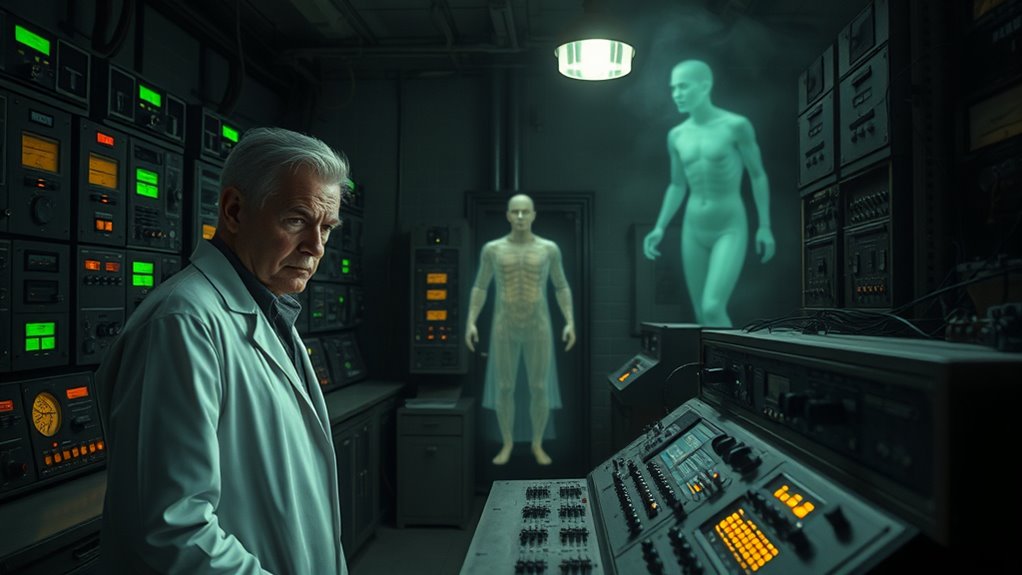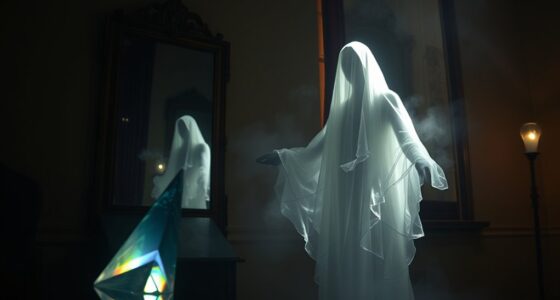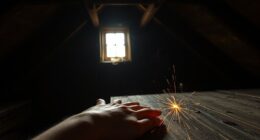Project Stargate was a secret CIA program that explored psychic phenomena like remote viewing to gather intelligence during the Cold War. Operated by scientists and military personnel, it used techniques like mental visualization and meditation to access hidden information. While some claims suggest the program achieved notable successes, skepticism remains due to limited verifiable evidence. If you want to uncover the true story behind these covert experiments and their impact, keep exploring the details.
Key Takeaways
- Project Stargate was a CIA program initiated during the Cold War to explore remote viewing and psychic phenomena for intelligence gathering.
- It involved key figures like Dr. Harold Puthoff and Ingo Swann, using techniques such as mental visualization and meditation.
- The program claimed successes in locating targets and gathering intelligence through clandestine remote viewing missions.
- Declassified documents reveal ethical concerns, secrecy, and ongoing debates over the program’s scientific validity and effectiveness.
- Although officially terminated, Project Stargate’s legacy influences popular culture and continues to spark speculation about psychic espionage.
Origins and Development of Psychic Research in the CIA
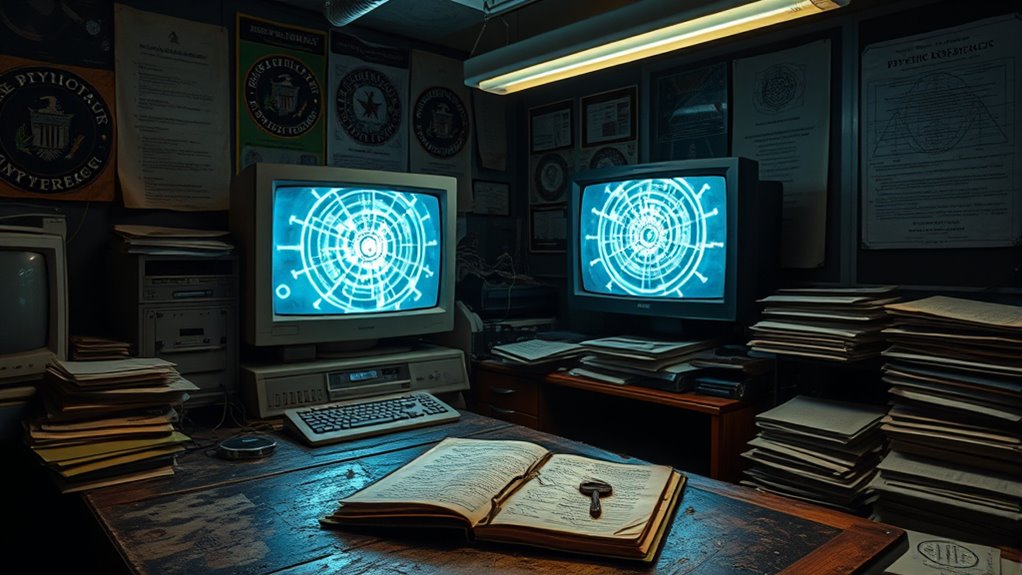
How did the CIA first get involved in psychic research? During the Cold War, interest in psychic phenomena grew, despite widespread historical skepticism about their legitimacy. The agency saw potential in remote viewing and extrasensory perception as tools for intelligence gathering. Ethical considerations, however, complicated funding and approval processes, as concerns about manipulating or exploiting such abilities arose. Initially, the CIA’s efforts were cautious, driven by the desire to avoid public backlash and scientific ridicule. Over time, classified projects like Stargate evolved from covert experiments to formal programs, reflecting a mix of curiosity and strategic interest. While skeptics questioned the validity, the CIA persisted, convinced that uncovering psychic spies could provide a crucial edge in espionage. Understanding the importance of verification became central to evaluating the results of psychic research. This focus on scientific validation aimed to differentiate genuine phenomena from potential fraud or misinterpretation, ensuring the program’s credibility. Additionally, the pursuit of empirical evidence was essential to establish the legitimacy of these techniques within the scientific community, especially given the historical skepticism surrounding psychic claims. Moreover, the experiments faced challenges related to methodological rigor, which impacted the overall credibility and acceptance within scientific circles.
Key Figures and Researchers Behind the Program

Among the key figures behind the CIA’s psychic research program were scientists, military personnel, and intelligence officers who believed in the potential of remote viewing. These individuals conducted ESP experiments and explored mind control techniques to access psychic phenomena. Notable figures included Dr. Harold Puthoff, who specialized in remote viewing, and Ingo Swann, a psychic researcher credited with pioneering many early ESP experiments. Their work aimed to harness psychic abilities for intelligence gathering. The program also involved military officers like Joseph McMoneagle, who claimed to have used remote viewing in field operations. The following table highlights some influential figures:
| Name | Role |
|---|---|
| Dr. Harold Puthoff | Lead researcher on ESP experiments |
| Ingo Swann | Psychic consultant and experimenter |
| Joseph McMoneagle | Remote viewer and field operative |
The Techniques and Methods Claimed to Be Used

You might wonder what techniques the program claimed to use to access hidden information. Proponents say they employed various psychic methods, especially remote viewing, to gather intelligence from afar. Understanding these methods helps clarify how the CIA believed they could harness psychic abilities for espionage purposes. Some accounts suggest that techniques akin to meditative focus were employed to enhance psychic sensitivity and perception. Additionally, practices such as mental visualization were reportedly used to improve the accuracy of remote viewing sessions. The program also purportedly incorporated psychic training to refine and develop these abilities further.
Psychic Techniques Employed
Proponents of Project Stargate claim that the program employed a variety of psychic techniques designed to enhance remote viewing and other extrasensory abilities. These methods often involved attempts at mind control, aiming to tap into subconscious processes that could reveal hidden information. Participants reportedly used meditation, visualization, and controlled focus to access paranormal phenomena, believing these techniques could unbolt hidden knowledge. The techniques were often shrouded in secrecy, emphasizing mental training to amplify intuitive insights. Some researchers suggest that these practices aimed to strengthen mental discipline and suppress doubts, making psychic impressions clearer. Additionally, the use of low light environments was thought to facilitate deeper concentration and mental clarity during sessions. While skeptics dismiss these methods as placebo, supporters argue they tapped into genuine paranormal phenomena, leveraging mind control strategies to unbolt hidden human potential for espionage purposes. In fact, the emphasis on mental discipline was believed to play a crucial role in maximizing the effectiveness of these psychic techniques, as suggested by some experimental outcomes. Furthermore, the development of sensory processing skills was considered essential in refining the accuracy of remote viewing sessions, with some theories proposing that these techniques could alter perception at a fundamental level. Some studies also explore the role of psychic training programs in systematically improving these abilities over time.
Remote Viewing Methods
Remote viewing methods in Project Stargate reportedly involved structured techniques aimed at accessing distant or hidden information through the mind. You begin with psychic training to sharpen your focus and enhance your intuitive skills. Visualization techniques are central, helping you picture the target location or object clearly in your mind. During sessions, you relax and enter a meditative state, allowing your subconscious to surface impressions. These methods often involve a feedback loop to refine accuracy. Incorporating dream recall practices can help improve the clarity and detail of the impressions received during remote viewing sessions. Below is a simplified overview:
| Step | Description |
|---|---|
| Preparation | Relaxation and mental focus |
| Visualization | Imagining the target scene |
| Feedback | Comparing impressions to reality |
| Refinement | Improving accuracy over time |
These techniques aimed to uncover hidden information using disciplined mental exercises, often incorporating meditative states to improve focus. Developing mental discipline is crucial for maintaining consistency and precision in remote viewing practices.
Notable Missions and Alleged Successes
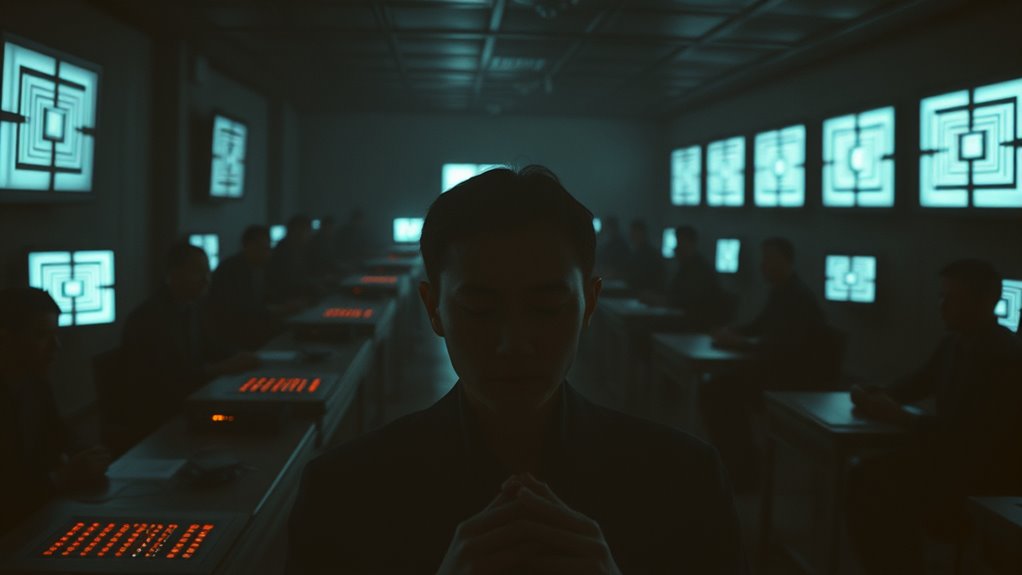
You might find it surprising that some remote viewing achievements are claimed to have provided valuable intelligence. Notable psychic missions reportedly led to breakthroughs in understanding enemy activities, though details remain secret. These alleged successes continue to fuel debates about the true potential of psychic phenomena in intelligence work.
Remote Viewing Achievements
Throughout the CIA’s Stargate program, several missions claimed remarkable successes that supporters cite as evidence of remote viewing’s potential. These achievements suggest that individuals could access information beyond normal senses, tapping into psychic phenomena. Some remote viewers reportedly described distant locations or sensitive targets with surprising accuracy, fueling hopes that this skill could be harnessed for intelligence. Critics, however, argue that these successes are inconsistent and could be explained by chance or subconscious cues. The program also fueled speculation about mind control experiments, blurring lines between genuine psychic ability and manipulation. While definitive proof remains elusive, these alleged achievements continue to intrigue, hinting at a hidden domain of psychic phenomena that might someday be understood or applied in intelligence operations.
Notable Psychic Missions
What are some of the most notable psychic missions claimed by the Stargate program? Reports suggest that, under government secrecy, psychic agents attempted mind control operations and remote viewing missions with limited success. Some alleged successes include pinpointing enemy locations or gathering intelligence from behind enemy lines. These missions often involved clandestine efforts to influence or extract information without direct contact. Skeptics argue that many claims lack verifiable evidence, while supporters believe these missions demonstrated real psychic potential. The secrecy surrounding the program fuels speculation about hidden successes. Despite doubts, the notoriety of these missions persists in conspiracy circles, fueling ongoing debates over whether psychic abilities could have been harnessed for covert operations.
Alleged Intelligence Breakthroughs
Among the claims surrounding Project Stargate, some reports suggest that psychic agents achieved notable breakthroughs in gathering intelligence. Supporters argue that paranormal phenomena like remote viewing provided valuable insights, potentially saving lives and preventing threats. These alleged successes are often shrouded in government secrecy, making verification difficult. Skeptics dismiss them as anecdotal or coincidental, citing the lack of concrete evidence. Nonetheless, the idea persists that psychic spies may have penetrated secret locations or identified targets with unusual accuracy. While official agencies remain tight-lipped, the stories of these alleged breakthroughs continue to fuel curiosity and debate, leaving open the possibility that some level of psychic phenomena could have played a role in intelligence efforts.
Public Disclosure and Declassification of Documents

Public disclosure and declassification of documents related to Project Stargate have considerably shaped public understanding of the program. These releases reveal insights into covert operations, raising ethical implications about government transparency. As you explore these documents, you’ll notice how they:
- Highlight the tension between governmental secrecy and public right to know
- Raise questions about the ethical boundaries of psychic research
- Show how information was gradually released, often under pressure
- Spur debates on whether declassification helps or harms national security
While transparency has increased, it also prompts concerns about accountability. You’re left to contemplate if revealing these documents clarifies the program’s true purpose or exposes uncomfortable truths about ethical limits in intelligence efforts.
The Scientific Community’s Response and Skepticism
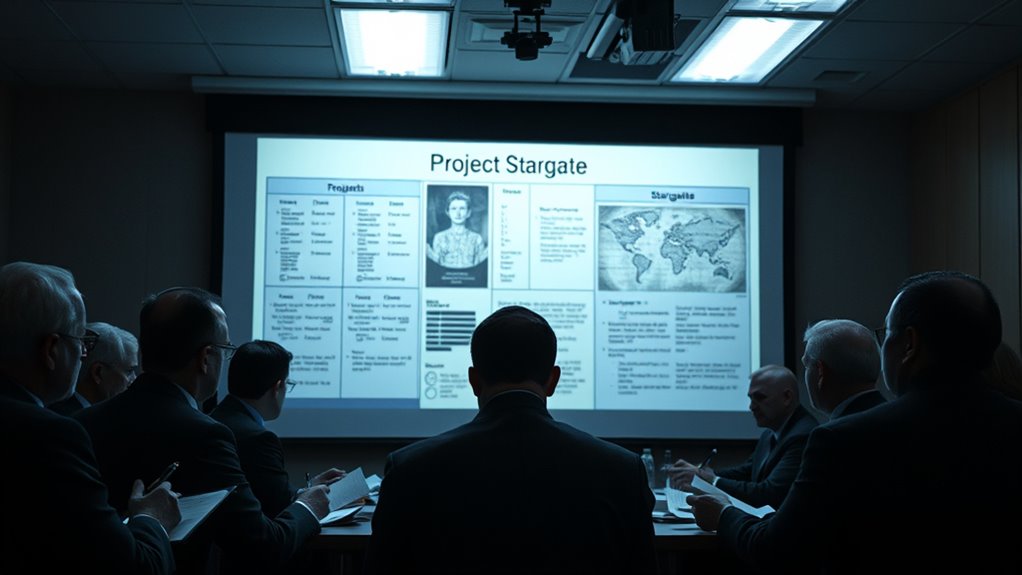
The scientific community largely responded to Project Stargate with skepticism, questioning the validity of claims surrounding psychic phenomena. They emphasized the importance of scientific skepticism and rigorous peer review to validate such extraordinary assertions. Many researchers argued that the evidence was anecdotal and lacked reproducibility, which are critical for scientific acceptance. This cautious stance reflects a broader wariness about unproven claims that challenge established scientific understanding. To assess the validity of psychic phenomena, scientists called for transparent methodology and independent verification. Despite some intriguing results, the absence of consistent, replicable data kept the scientific community from accepting the claims. The table below summarizes key responses:
| Response Aspect | Description |
|---|---|
| Skepticism Level | High, due to lack of reproducible results |
| Peer Review Process | Critical, often found flaws in methodology |
| Reproducibility | Frequently questioned, inconsistent findings |
| Scientific Validity | Remained unproven, controversial |
| Community Consensus | Generally dismissive without strong evidence |
Cultural Impact and Portrayal in Media
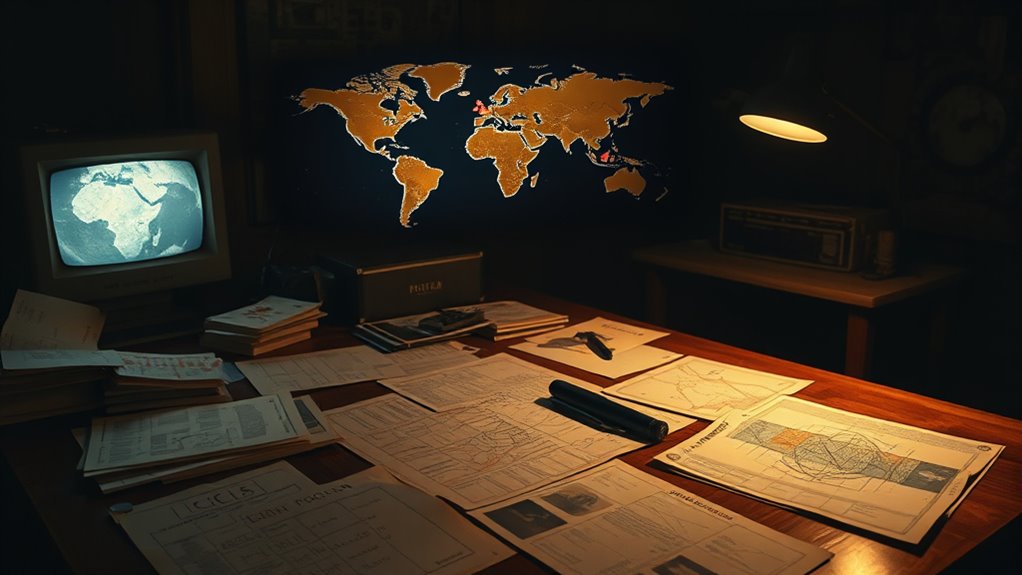
Project Stargate has considerably influenced popular culture and media portrayals of psychic phenomena, shaping perceptions of the program’s abilities and motives. You often encounter references in movies, TV shows, and books that depict psychic spies using telepathy or remote viewing to gather secrets. These media portrayals tend to dramatize or exaggerate the program’s capabilities, fueling public fascination. Some notable pop culture references include:
- TV shows like “The X-Files” featuring psychic investigations
- Films depicting mind-reading and remote viewing missions
- Documentaries exploring government secrecy and conspiracy theories
- Video games incorporating psychic powers as gameplay elements
These portrayals blur the line between fact and fiction, leaving you with a lasting impression of Project Stargate’s mysterious and often sensationalized reputation.
The Legacy and Current Status of Psychic Intelligence Programs

Have psychic intelligence programs left a lasting mark on government operations and public perception? While official programs like Project Stargate were officially terminated decades ago, their legacy persists in debates over ethical concerns and funding controversies. Critics question whether investing in psychic research was justified, citing the lack of concrete results and potential misuse of government funds. Some believe these programs spurred secretive experiments that eroded public trust. Although current intelligence agencies deny ongoing psychic research, interest in remote viewing and similar techniques continues in fringe circles. The broader legacy highlights the tension between exploring unconventional methods and maintaining ethical standards. Ultimately, psychic intelligence programs serve as a cautionary tale about the risks of pursuing unproven methods in national security efforts.
Frequently Asked Questions
Were Any Actual Psychic Spies Ever Confirmed to Have Operated Successfully?
You might wonder if any psychic spies achieved operational success. While claims of psychic capabilities exist, there’s no solid proof confirming that any operated successfully in real-world missions. Despite ongoing research and secret programs, the evidence remains inconclusive. You should approach these stories skeptically, recognizing that, to date, no verified instances demonstrate psychic spies delivering reliable, actionable intelligence or operational success.
What Specific Government Agencies Collaborated With the CIA on This Program?
You might wonder who else was involved in this secret venture. Behind the scenes, military intelligence and scientific research agencies collaborated closely with the CIA. Their combined efforts aimed to unlock hidden powers, blending espionage with cutting-edge science. These alliances fueled the program’s mysterious nature, making it a enthralling chapter in intelligence history. The true extent of their partnership remains shrouded in secrecy, leaving you intrigued about what was truly possible.
Are There Any Ongoing or Successor Programs to Stargate Today?
You wonder if any current programs continue psychic research amid government secrecy. While official details are scarce, some speculate that agencies like the Defense Intelligence Agency or the DIA might still explore such areas covertly. These efforts, if they exist, operate under tight secrecy, making it difficult to confirm. Overall, government secrecy likely keeps any ongoing or successor programs hidden from public view, fueling ongoing speculation about psychic research’s role today.
How Did Public Perception Influence the Program’S Secrecy or Exposure?
Imagine a lighthouse battling stormy seas—that’s how public skepticism and media influence shaped secrecy around covert programs. Your awareness of government projects often fluctuates with media reports, which can either mask or expose secrets. Public skepticism fueled suspicion, leading authorities to hide sensitive info, while media coverage could also reveal partial truths. This tug-of-war influenced how openly agencies shared details, balancing national security against public perception.
What Are the Most Credible Declassified Documents Supporting the Program’s Existence?
You’ll find that declassified files are your best source for credible evidence, as they come directly from official channels. These documents, released through Freedom of Information Act requests, confirm the program’s existence and activities. Credible sources like CIA archives and government reports provide detailed insights, helping you understand the historical context. While some materials remain classified, what’s been declassified offers a reliable foundation for understanding the program’s scope and purpose.
Conclusion
As you explore Project Stargate, remember that truth is often stranger than fiction. While the program claimed remarkable feats, skepticism remains, reminding you that not everything that glitters is gold. Whether it was groundbreaking or just a myth, the story highlights how curiosity drives us to seek the unknown. In the end, it’s a reminder that sometimes, the greatest discoveries come from daring to believe in the impossible.
